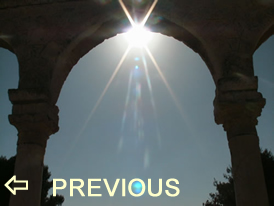| |

|
September 22 - Morning
"Many have undertaken to draw up an account of
the things that have been fulfilled among us, just
as they were handed down to us by those who from
the first were eyewitnesses and servants of the word. With this in mind, since I myself have carefully investigated everything from the beginning, I too decided to write an orderly account."
- Luke 1:1-3
|
 |
|
Interviewing the Eye Witnesses and Investigating the Facts |
|
|
Luke begins his book by telling the reader that he himself has:
- “carefully investigated everything”
- interviewed “eyewitnesses”
- examined the authorized accounts “handed down to us”
- wrote a orderly account of the historical narrative
To think that Luke is writing something that is unreliable is to say the author is lying in the very introduction of the book. Luke intends for his book to be read as historical fact.
Luke says that many people in 57 AD had already “undertaken to draw up an account” of the
details concerning the Life of Jesus. The words “an account” are from “diegesis” in the Greek,
a word that is used consistently to refer to literature written as a historical narrative presented with details and order. The author, Luke, is not writing fiction, allegory, philosophy, poetry or a novel.
Luke, who was a medical doctor from Antioch, was most likely trained in the medical school
at Troas where he joined Paul’s missionary team in 49-50 AD. Luke was with Paul during his imprisonment in Caesarea (57-59) and Paul’s two-year imprisonment in Rome (60-62). Luke could have used these years to collect information, interview people who had firsthand experience with Jesus and then investigated facts. In fact, this is what Luke says in his introduction to the
book we call the Gospel of Luke.
Luke begins by saying that many people have already tried to record the things concerning Jesus - “many have undertaken to draw up an account.” Luke states that he, too, wanted “to write an
orderly account,” or literally, “accurately in order.” This phrase refers to a systematic and logical account. In 1:2 Luke uses the Greek word “paradidomi” (translated “handed down”) to refer to the authorized traditions carefully preserved and taught among the churches concerning the life of
Jesus in 57 AD, twenty-seven years after the resurrection. Remember the apostles were still
alive and serving as witnesses to the life and teachings of Jesus.
Luke also spent time talking to “eyewitnesses” of Jesus. This could have included conversations
and interviews with Jesus’ mother Mary, any number of the 120 disciples from the Upper Room in Acts 1:15, people who had been healed or people who had listened to Jesus teach. In fact, with
this in mind, it is interesting that only Luke gives us details of some of the events in Jesus life.
These accounts most likely came from people who were present or directly involved in the events
that were interviewed by Luke. Thirty-five percent of Luke’s gospel is unique and not found in the
other gospels. No writer records these events other than Luke who also provides details and conversation around these events:
- The story of the birth of John the Baptist and the conversation between Gabriel and Zechariah in the Temple (Luke 1)
- Gabriel’s conversation with Mary announcing the birth of Jesus (Luke 1:26-38)
- Mary’s visit to see Elizabeth and Mary’s song of praise (Luke 1:39-56)
- Details of the birth of Jesus including the visit of the shepherds (Luke 2:1-39)
- Jesus in the Temple as a 12 year old boy and his parents leaving him behind (Luke 2:41-52)
- Zacchaeus in Jericho (Luke 19)
- Prodigal Son (Luke 15:11-32)
- Good Samaritan (Luke 10:25-37)
|
|
 |
“By faith alone,
through grace alone,
by the Scriptures alone.”
“Sola fide,
sola gratis,
sola Scriptura”
|
 |
" 'And the common people heard Him gladly, for He taught them as one having authority.' These sentences reveal the very heart of effective speaking."
– Albert Jeremiah Beveridge (1862-1927),
American historian,
US senator |
|
| |
|
|
| |
|
 |
 |
 |
 |
| For favor with people |
Attitude of encouragement |
Freedom of Religion |
Nigeria - integrity, unity and courage in church leadership |
|
|
| |
 |
 |

The Siloam Inscription was written in 701 BC and discovered in 1880. It was engraved in the wall of the tunnel, but later chiseled out of the bedrock and taken to a museum in Istanbul, Turkey.
Inscribed by one of Hezekiah’s workmen near the western end
of the tunnel close to the Pool of Siloam, it reads:
[…when] (the tunnel) was driven through. And this was the way in which it was cut through: While [ . . .] (were) still [ . . . ] axes, each man toward his fellow, and while there were still three cubits to be cut through, [there was heard] the voice of a man calling to his fellows, for there was an overlap in the rock on the right [and on the left]. And when the tunnel was driven through, the quarrymen hewed (the rock), each man toward his fellow, axe against axe; and the water flowed from the spring toward the reservoir for 1200 cubits, and the height of the rock above the heads
of the quarrymen was 100 cubits.
- Siloam Inscription, engraved in 701 BC
(click on image for larger size)
|
|

Map of the Cities of Israel
(click on image for larger size) |
| |
|
| |
|
| Details and Explanation of Sets & Reps Devotional System Here |
 |
|
|
| |
| |
| |
| Reps & Sets is a daily Bible devotional for Christians from Generation Word Bible Teaching used each morning and evening. |
| |
|